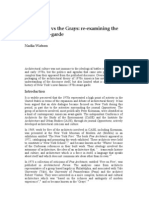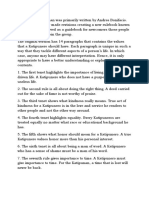Professional Documents
Culture Documents
Analysis of The Kartilya NG Katipunan
Analysis of The Kartilya NG Katipunan
Uploaded by
Brian Tamayo Colcol0 ratings0% found this document useful (0 votes)
1K views2 pagesThis document analyzes the "Kartilya ng Katipunan", a founding document of the Katipunan revolutionary group against Spanish colonial rule. It discusses how the Kartilya promoted ideals of equality, tolerance and freedom in response to the unjust hierarchy that treated indigenous people as inferior. While some provisions regarding gender could be criticized today, the Katipunan was advanced for its time in recognizing women as partners in the struggle. The document also discusses how the Kartilya's teachings instructed both self-development and treatment of neighbors, in pursuit of the Katipunan's ideals of an alternative social order.
Original Description:
Original Title
Analysis of the Kartilya ng Katipunan
Copyright
© © All Rights Reserved
Available Formats
PDF, TXT or read online from Scribd
Share this document
Did you find this document useful?
Is this content inappropriate?
Report this DocumentThis document analyzes the "Kartilya ng Katipunan", a founding document of the Katipunan revolutionary group against Spanish colonial rule. It discusses how the Kartilya promoted ideals of equality, tolerance and freedom in response to the unjust hierarchy that treated indigenous people as inferior. While some provisions regarding gender could be criticized today, the Katipunan was advanced for its time in recognizing women as partners in the struggle. The document also discusses how the Kartilya's teachings instructed both self-development and treatment of neighbors, in pursuit of the Katipunan's ideals of an alternative social order.
Copyright:
© All Rights Reserved
Available Formats
Download as PDF, TXT or read online from Scribd
Download as pdf or txt
0 ratings0% found this document useful (0 votes)
1K views2 pagesAnalysis of The Kartilya NG Katipunan
Analysis of The Kartilya NG Katipunan
Uploaded by
Brian Tamayo ColcolThis document analyzes the "Kartilya ng Katipunan", a founding document of the Katipunan revolutionary group against Spanish colonial rule. It discusses how the Kartilya promoted ideals of equality, tolerance and freedom in response to the unjust hierarchy that treated indigenous people as inferior. While some provisions regarding gender could be criticized today, the Katipunan was advanced for its time in recognizing women as partners in the struggle. The document also discusses how the Kartilya's teachings instructed both self-development and treatment of neighbors, in pursuit of the Katipunan's ideals of an alternative social order.
Copyright:
© All Rights Reserved
Available Formats
Download as PDF, TXT or read online from Scribd
Download as pdf or txt
You are on page 1of 2
Analysis of the "Kartilya ng Katipunan
This primary source also needs to be analyzed in terms of content
and context. As a written document for a fraternity whose main purpose
is to overthrow a colonial regime, we can explain the content and
provisions of the Kartilya as a reaction and response to certain value
systems that they found despicable in the present state of things that
they struggled against with. For example, in the fourthand the thirteen
rules in the Kartilya are an invocation of the inherentequality between
and among men regardless of race, occupation or status. In the context
of the Spanish colonial era where the indios were treated as the inferior
of the white Europeans, the Katipunan saw to it that the alternative
order that they wished to promulgate through their revolution
necessarily destroyed this kind of unjust hierarchy.
Moreover, one can analyze the values upheld in the document as
consistent with the burgeoning rational and liberal ideals in the
eighteenth and nineteenth century. Equality, tolerance, freedom, and
liberty were values that first emerged in the eighteenth century French
Revolution, which spread throughout Europe and reached the educated
class of the colonies. Jacinto,an ilustrado himself, certainly got an
understanding of these values. Aside from the liberal values that can
be dissected in the document, we can also decipher certain Victorian
and chivalrous values in the text. For example, various provisions in
the Kartilya repeatedly emphasized the importance of honor in words
and in action. The teaching of the Katipunan on how women should be
treated with honor and respect, while positive in many respects and
certainly a significant stride from the practice of raping and physically
abusing women, can still be telling of the Katipunan's secondary regard
for women in relation to men. For example, in the tenth rule, tne
document of specifically stated that men should be the guide of women
and children, and that he should set a good example, otherwise the
women and children would be guided guided in the path of evil.
Nevertheless, the same documents stated that women should be
treated as companions of men not as playthings that can be exploited
for their pleasure.
ln the contemporary eyes, the Katipunan can be criticizedbecause
of these provisions. However, one must not forget the contextwhere the
organization was born. Not even in Europe or in the whole of the West
at that juncture recognized the problem of genderinequality. Indeed, it
can be argued that Katipunan's recognition of women as important
partners in the struggle, as reflected not just in Kartilya but also in the
organizational structure of the fraternity where a women's unit was
established, is an endeavor advanced for its time. Aside from Rizal's
known Letter to the Women of Malolos, no same effort by the supposed
cosmopolitan Propaganda Movement was achieved until the
movement's eventual disintegration in the latter part of the 1890s.
Aside from this, the Kartilya was instructive not just of the
Katipunan's conduct toward other people, but also for the members'
development as individuals in their own rights. Generally speaking, the
rules in the Kartilya can be classified as either directed to how oneshould
treat his neighbor or to how one should develop and conduct one's self,
Both are essential to the success and fulfillment of the Katipunan's
ideals. For example, the Kartilya's teachings on honoringone's word and
not wasting time are teachings directed toward self- development,
while the rules on treating the neighbor's wife, children,and brothers the
way that you want yours to be treated is an instruction on how
Katipuneros should treat and regard their neighbors.
All in all, proper reading of the Kartilya will reveal a more
thorough understanding of the Katipunan and the significant role thatit
played in the revolution and in the unfolding of the Philippine history,as
we know it.
You might also like
- Study Notes ACCA - Financial Reporting PDFDocument211 pagesStudy Notes ACCA - Financial Reporting PDFLavinia Minoiu100% (1)
- Reinforcement Activity No. 1 The Paintings of Juan LunaDocument2 pagesReinforcement Activity No. 1 The Paintings of Juan LunaIntrovert Dipshit100% (1)
- Kartilya NG KatipunanDocument2 pagesKartilya NG KatipunanbuttewcupzNo ratings yet
- Reporting - Customs-of-The-TagalogsDocument47 pagesReporting - Customs-of-The-Tagalogsblackfire_sanmelNo ratings yet
- Customs of The Tagalogs Module ReviewerDocument6 pagesCustoms of The Tagalogs Module ReviewerChris Deinielle Marcoleta SumaoangNo ratings yet
- Readings in Philippine History: Mr. Isaac NavarroDocument25 pagesReadings in Philippine History: Mr. Isaac Navarroinno so qtNo ratings yet
- Guide QuestionsDocument4 pagesGuide Questionscamela caranzo100% (2)
- Circle KDocument491 pagesCircle Kpascal rosasNo ratings yet
- Obligation Drill 2Document2 pagesObligation Drill 2Maurren SalidoNo ratings yet
- Whites Vs GreysDocument15 pagesWhites Vs GreysHazem Saleh40% (5)
- A Presentation On "Blades Inc. Case (Direct Foreign Investment) "Document10 pagesA Presentation On "Blades Inc. Case (Direct Foreign Investment) "devrajkinjal100% (2)
- "Analysis of The "Kartilya NG Katipunan": Struggled Against With.1Document2 pages"Analysis of The "Kartilya NG Katipunan": Struggled Against With.1Mark Ronald Suaiso100% (1)
- Kartilya RPHDocument15 pagesKartilya RPHArchen NoteNo ratings yet
- Chapter 2B - KKK KartilyaDocument42 pagesChapter 2B - KKK KartilyaBOLNEO, Mary JacquelineNo ratings yet
- Answer What Is Being Asked. (100 Points) Instructions: Read The Provisions of The Kartilya NG Katipunan and Through It, Visualize The Dynamics ofDocument2 pagesAnswer What Is Being Asked. (100 Points) Instructions: Read The Provisions of The Kartilya NG Katipunan and Through It, Visualize The Dynamics ofVhon MisakiNo ratings yet
- The Katipunan Manifesto: Inspirations of Emilio Jacinto in Writing The Kartilya NG KatipunanDocument9 pagesThe Katipunan Manifesto: Inspirations of Emilio Jacinto in Writing The Kartilya NG KatipunanLouie Jay LegaspiNo ratings yet
- GE8 - What Is The Primary Reason of The Author in Writing The Documents How Was It ProducedDocument2 pagesGE8 - What Is The Primary Reason of The Author in Writing The Documents How Was It ProducedTimothy James AlmasaNo ratings yet
- Reading in Philippine HistoryDocument14 pagesReading in Philippine HistoryJames Philip RelleveNo ratings yet
- Filipino Grievances Against Governor WoodDocument9 pagesFilipino Grievances Against Governor WoodZaid BawariNo ratings yet
- Ang Kartilya Ni Emilio Jacinto Group 5Document27 pagesAng Kartilya Ni Emilio Jacinto Group 5Sarah Quijan BoneoNo ratings yet
- RPHDocument2 pagesRPHpau santos0% (1)
- Assignment: 13: Jabay, Jessa M. BSA 2-13Document3 pagesAssignment: 13: Jabay, Jessa M. BSA 2-13JessaNo ratings yet
- Felipe, Cindy S. Bsba 1B-Fm Reflection Paper The KKK and The Kartilya of The KatipunanDocument1 pageFelipe, Cindy S. Bsba 1B-Fm Reflection Paper The KKK and The Kartilya of The KatipunanCindy Felipe100% (1)
- Analysis Kartilya NG Katipunan Was Primarily Written by Andres BonifacioDocument9 pagesAnalysis Kartilya NG Katipunan Was Primarily Written by Andres BonifacioNicolejoy FriasNo ratings yet
- Activity 5 The Voyage Around The WorldDocument2 pagesActivity 5 The Voyage Around The WorldClariza PascualNo ratings yet
- Life and Works of Emilio D. Jacinto - PPTMDocument36 pagesLife and Works of Emilio D. Jacinto - PPTMJoel BatucanNo ratings yet
- Bangsamoro Organic LawDocument1 pageBangsamoro Organic LawMark John EchanoNo ratings yet
- Act of The Declaration of Philippine Independence: Acta de La Proclamacíon de Independencia Del Pueblo FilipinoDocument30 pagesAct of The Declaration of Philippine Independence: Acta de La Proclamacíon de Independencia Del Pueblo FilipinoAlex HollidayNo ratings yet
- KKK and The Kartilya of The KatipunanDocument1 pageKKK and The Kartilya of The KatipunanCindy Felipe100% (1)
- Chapter 2 ActivitiesDocument3 pagesChapter 2 Activitiesmaj lauNo ratings yet
- Life and Works of Rizal Compromisers Vs Plebian ConstiuencyDocument1 pageLife and Works of Rizal Compromisers Vs Plebian ConstiuencySapag PatakNo ratings yet
- The Causes of The Distress of The PhilippinesDocument14 pagesThe Causes of The Distress of The PhilippinesMarillac CelestialNo ratings yet
- Narrative Report Cavite MutinyDocument2 pagesNarrative Report Cavite MutinyKATHLENE M. CAGAS100% (1)
- March 29, 1521 (Holy Friday) : The CaptainDocument4 pagesMarch 29, 1521 (Holy Friday) : The Captainkairos sunsetNo ratings yet
- RPHREVOLTDocument2 pagesRPHREVOLTCarlos Miguel Andal100% (1)
- Point of View of RizalDocument16 pagesPoint of View of RizalMaryl Lee Navarro0% (1)
- First Cry of The Revolution and The Retraction of Rizal ModuleDocument16 pagesFirst Cry of The Revolution and The Retraction of Rizal ModulePrinces Jamela G. AgraNo ratings yet
- The Three (3) Questions That I Want To Ask About The Readings Are..Document1 pageThe Three (3) Questions That I Want To Ask About The Readings Are..Lester GarciaNo ratings yet
- Historical Context Behind Declaration of PH IndependenceDocument3 pagesHistorical Context Behind Declaration of PH IndependenceJericho Perez100% (1)
- EssayDocument1 pageEssayZup Thanks33% (3)
- Kartilya NG KatipunanDocument6 pagesKartilya NG KatipunanDCRUZNo ratings yet
- Content and Contextual Analysis - Kartilya NG KatipunanDocument5 pagesContent and Contextual Analysis - Kartilya NG KatipunanJOHN LAWRENCE LOBATONNo ratings yet
- RIPH Reaction PaperDocument7 pagesRIPH Reaction PaperINLONG JOHN KEVIN PUNZALANNo ratings yet
- Content and Context Analysis - Customs of TagalogsDocument3 pagesContent and Context Analysis - Customs of TagalogsKyla Jynell SaquitonNo ratings yet
- History of Aguilar PangasinanDocument3 pagesHistory of Aguilar PangasinanHyung Bae50% (2)
- GROUPWORKDocument2 pagesGROUPWORKCatherine SamsonNo ratings yet
- Exercise 2.2Document2 pagesExercise 2.2Almavilla Bantayan100% (1)
- BSA-1A Module2Document4 pagesBSA-1A Module2Romina Lofamia LlamadoNo ratings yet
- Bud DajoDocument8 pagesBud DajoJoseph Lester Nala100% (2)
- HINDAP - MODULE1 - BSEdIISCIENCE - Jessa HindapDocument11 pagesHINDAP - MODULE1 - BSEdIISCIENCE - Jessa HindapJunjun CaoliNo ratings yet
- Father Jose BurgosDocument2 pagesFather Jose BurgosItsmeKhey Phobe Khey BienNo ratings yet
- Context of Pigafetta and Plasencia DocumentsDocument21 pagesContext of Pigafetta and Plasencia DocumentsKyledana Francisco33% (3)
- Cavite MutinyDocument18 pagesCavite MutinyMyca CruzNo ratings yet
- Contextual Analysis About "Palay Maiden" by Fernando AmorsoloDocument4 pagesContextual Analysis About "Palay Maiden" by Fernando AmorsoloRosen Anthony0% (1)
- All About The KKK and Proclamation of IndependenceDocument9 pagesAll About The KKK and Proclamation of IndependenceAriell EmraduraNo ratings yet
- Final Exam RIPHDocument4 pagesFinal Exam RIPHJane AlmanzorNo ratings yet
- Module 1: Introduction To History: Learning ObjectivesDocument7 pagesModule 1: Introduction To History: Learning ObjectivesMariz Dioneda50% (2)
- Kartilya NG Katipunan Ni Emilio JacintoDocument6 pagesKartilya NG Katipunan Ni Emilio JacintoJessa A. QuilantangNo ratings yet
- Adjabay Jessa M. Module 3 Evaluation ActivityDocument1 pageAdjabay Jessa M. Module 3 Evaluation ActivityJessaNo ratings yet
- Customs of The TagalogDocument12 pagesCustoms of The TagalogStella Marie Neral100% (1)
- Reading 1: (Travelogue) Antonio Pigafetta's First Voyage Around The WorldDocument10 pagesReading 1: (Travelogue) Antonio Pigafetta's First Voyage Around The Worldabhie castilloNo ratings yet
- Compare and Contrast (ARTS)Document1 pageCompare and Contrast (ARTS)Liza LicarosNo ratings yet
- Document Analysis Worksheet DocumentDocument3 pagesDocument Analysis Worksheet DocumentJinky SanturiasNo ratings yet
- Presidents of The Philippines and Their AchievementsDocument9 pagesPresidents of The Philippines and Their AchievementsVash Gaming100% (1)
- Robin HoodDocument2 pagesRobin Hooddevilryder31No ratings yet
- Cabulohan-Paradise National High School-AnnexDocument3 pagesCabulohan-Paradise National High School-AnnexRUth SanNo ratings yet
- KPMGDocument6 pagesKPMGVarun SharmaNo ratings yet
- The 50-50 Strategy - Working Money - Charles B. SchaapDocument6 pagesThe 50-50 Strategy - Working Money - Charles B. Schaapmaheshmuralinair6No ratings yet
- Stralenfolter - Andrea LarocheDocument6 pagesStralenfolter - Andrea Larochestop-nwo-nazi-folterNo ratings yet
- PaperDocument28 pagesPapertserof21100% (1)
- SCMPE 1 New Question PaperDocument10 pagesSCMPE 1 New Question PaperMustafa KhanbhaiNo ratings yet
- Ziel b2Document3 pagesZiel b2Abhijeet ChopraNo ratings yet
- 2022-17-13 Piaggio Aero Industries S.p.A.: Amendment 39-22151 Docket No. FAA-2022-0397 ProjectDocument2 pages2022-17-13 Piaggio Aero Industries S.p.A.: Amendment 39-22151 Docket No. FAA-2022-0397 ProjectDonald SimsNo ratings yet
- A Victim Lost in Saqifah V 3Document100 pagesA Victim Lost in Saqifah V 3Akbar Ali Khan100% (1)
- Every Breath You Take Uke Tab by The PoliceDocument4 pagesEvery Breath You Take Uke Tab by The PoliceJefri Nur FahmiNo ratings yet
- Aeroshell Book 10busspecsDocument8 pagesAeroshell Book 10busspecsDerqui Andres Avalo100% (1)
- Language Programs and Policies in Multilingual-SocietiesDocument95 pagesLanguage Programs and Policies in Multilingual-SocietiesRenren OconNo ratings yet
- Elbe Sandstone MountainsDocument7 pagesElbe Sandstone Mountainspucca110No ratings yet
- (PS) Sakamoto v. US Office of Personnel Management - Document No. 6Document2 pages(PS) Sakamoto v. US Office of Personnel Management - Document No. 6Justia.comNo ratings yet
- Civil Works Schedule - Burgula 37.4MW ProjectDocument2 pagesCivil Works Schedule - Burgula 37.4MW Projectjagadeesh_kumar_20No ratings yet
- Tabel Bunga Ekonomi TeknikDocument32 pagesTabel Bunga Ekonomi TeknikTdaNo ratings yet
- Baghdad, IRAQDocument16 pagesBaghdad, IRAQAr Dinesh GaikwadNo ratings yet
- Irrigation Department: Government of Khyber PakhtunkhwaDocument4 pagesIrrigation Department: Government of Khyber Pakhtunkhwaalamgir BachaNo ratings yet
- My Management PhilosophyDocument21 pagesMy Management Philosophyapi-246203531No ratings yet
- Information Security Policy PDFDocument98 pagesInformation Security Policy PDFjohn paro100% (2)
- Chap 7 Worksheet 01Document5 pagesChap 7 Worksheet 01Lady Zyanien DevarasNo ratings yet
- Les Verbes Pronominaux ExplicationDocument7 pagesLes Verbes Pronominaux Explicationapi-383228642No ratings yet
- RWPPT For Final Demo - ExDocument33 pagesRWPPT For Final Demo - ExGuillermo AlvarezNo ratings yet
- Chapter Eight Advanced Investment AppraisalDocument18 pagesChapter Eight Advanced Investment Appraisalkuttan1000100% (1)

























































































